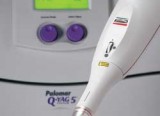Q switched Nd: Yag Laser
How does Nd: YAG laser work?
 Q switched Nd: YAG laser is a high-powered laser that removes unwanted tattoos and pigmented lesions (sun spots, freckles, etc.)
Q switched Nd: YAG laser is a high-powered laser that removes unwanted tattoos and pigmented lesions (sun spots, freckles, etc.)
It emits a highly focused beam of laser light, which passes harmlessly through the outer layer of the skin that can effectively shatter tattoo ink or the excess pigment within the lesion.
As the light is absorbed, it is quickly converted to heat.
The sudden rise in temperature within the treatment target fractures the ink or pigment into tiny particles.
Since laser targets the ink or melanin, it wouldn’t harm surrounding skin and tissue, reducing discomfort, side effects, and downtime.
Tattoo ink fragments are carried away by the lymphatic system, while pigmented lesions are naturally shed from the skin one to two weeks after treatment.
The laser treatment also tightens the collagen, improving certain types of rhytides (wrinkles) and other signs of photodamage (Sun damage).
What kinds of tattoos or pigmented lesions can be treated with Nd: YAG Laser?
A wide range of pigmented lesions can be treated, including Nevus of OTA, cafe-au-lait spots, Beckers Nevus, Melasma, Peutz-jegher’s spots, certain types of scars, lentigines, freckles, sunspots and many brown-coloured birthmarks.
A tattoo’s colour, depth, and chemical composition of ink affect how it responds to laser light. Black, red, dark orange, and dark blue tattoos will respond relatively quickly to treatments with the QSYL. However, green, purple, brown, light orange and light blue colours may require more treatments.
In general, most tattoos can be successfully treated, given a sufficient number of treatments. This laser is also used for reducing certain types of scars and wrinkles.
Does the Nd: YAG Laser treatment hurt?
Since the laser light selectively targets the undesired ink or pigment, other tissues remain largely unaffected, and therefore most patients report little discomfort. Many people compare the sensation of the pulses entering the skin to the snap of a rubber band. If such “snaps” are too uncomfortable, your physician may offer you local anaesthesia, but this is usually not necessary.
What happens after treatment?
Immediately after laser exposure, the treated areas may become whitish-coloured and swell slightly. This whiteness subsides in about 30 minutes. The swelling may last longer but can be reduced by cooling the skin with an ice pack. The tattoo or pigmented lesion will fade over the next few weeks.
How long does it take?
Depending on the size and location of the tattoo or lesion, each treatment usually takes about 10 to 30 minutes. Some faint tattoos and pigmented lesions will fade completely after only one treatment, though most may require five treatments or more. Treatments are spaced six to eight weeks apart to give your body sufficient time to eliminate loosened particles of ink or pigment.
Although patients may need a series of treatment sessions to achieve their desired results, the improvements will be long-lasting.
Are there any side effects?
Side Effects are rare as a result of treating with Nd: Yag Laser. When side effects do occur, they are usually mild and confined to the treatment target.
What are the alternative treatments?
The alternatives for pigmented lesion removal vary, depending on the nature of the lesion. In the case of tattoo removal, however, laser treatment is the only effective method that is unlikely to cause any scarring; the alternatives to laser tattoo and pigmented lesion removal include:
Surgical excision
- Salabration (using salt to burn away layers of skin).
- Chemical peels (using acid to burn away layers of skin).
These methods not only cause scars but can also be painful. That’s why Q-switched Nd: YAG Laser is the tool of choice for most tattoo removal practitioners.
